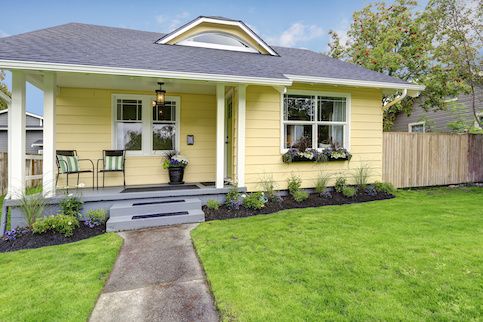What Is A 40-Year Mortgage And Is It Right For You?

Looking for ways to make your mortgage payment more affordable? A 40-year, fixed-rate mortgage may help. Purchasing a home with a 40-year loan or refinancing your existing mortgage to this long-term option can lower your payment, but you could end up paying more in total interest.
Whether it’s a good option for you will depend on your financial goals. Read on to learn more about this type of loan, how to get it and other options you may have.
What Is A 40-Year Mortgage?
As the name suggests, a 40-year mortgage is a home loan with a term of 40 years. If you hold this loan to full term, it will take you 480 monthly payments to pay it off.
Like other mortgages, you’ll pay this loan off with regular monthly payments that include interest. With a fixed-rate loan, your interest rate will never change.
The challenge might be in finding a 40-year mortgage. These loan types aren’t as common as 15-year or 30-year, fixed-rate loans. That’s partly because they are not considered conforming loans. These are loans that meet the lending standards set by Fannie Mae and Freddie Mac. You also won’t find any 40-year mortgages that are insured by government agencies, such as FHA, VA or USDA loans.
See What You Qualify For
Home Purchase
Home Refinance
Tap Into Equity
How Can You Get A 40-Year Mortgage?
If you’re looking for the lowest possible mortgage payment, a 40-year, fixed-rate home loan might be the choice for you. Here are some ways in which you can get one of these longer-term loans.
Home Purchase
When you purchase a home, you can apply for a 40-year mortgage from a lender that offers one. In fact, in some of the most expensive real estate markets in the country, you might be unable to afford a home if you take out a shorter-term mortgage such as a 15-year, fixed-rate loan. That’s because your monthly payment will be higher with a shorter-term loan. A 40-year loan stretches out your payments, giving you more time to pay off the loan, thus making the payments smaller.
Be careful when taking this approach, though. Yes, your payments will be lower with a 40-year loan, but the price of the home you’re buying does not shrink just because you are paying less each month. With a longer-term loan, you will pay more in total interest, and it will take you longer to build equity. This can prove challenging if you want to sell your home or refinance. If you don’t have enough equity – the difference between what your home is worth and what you owe on your mortgage – you might not make much of a profit when you sell. And if you don’t have at least 20% equity in your home, you might not be able to refinance.
The key is to look at your finances to determine if the home you want to buy is truly affordable to you, no matter the size of your monthly mortgage payment.
To get a better idea of how much home you can afford, use our home affordability calculator and create a homeownership budget.
Refinance From A Shorter-Term Mortgage
You can also refinance from a shorter-term mortgage to a 40-year loan. This can be helpful for homeowners who are struggling to make their mortgage payments each month. By refinancing to a longer-term loan, you could reduce your monthly mortgage payment to one that fits more comfortably in your budget. If your loan term is under 30 years, you could also refinance your current mortgage into a new 30-year fixed-rate mortgage, which may be more accessible and could still lower your payment.
If your finances improve, you might be able to refinance back to a shorter-term loan. This would reduce the amount of interest you pay overall. And if you wait until mortgage interest rates fall, you might end up with an interest rate that is significantly lower than the one attached to your longer-term loan.
When it comes to taking action to achieve your specific financial goals, it’s always recommended you speak to a financial advisor.
How To Get A 40-Year Loan
The steps you’d take to apply for a 40-year loan are similar to the ones you’d take when going through the typical mortgage application process.
- Apply For Initial Approval
Before you start looking for a home, you should get preapproved for your 40-year mortgage. During this initial approval process, your lender will review your credit and verify your income. To help with this, you’ll provide copies of your two most recent paycheck stubs, last 2 months of bank account statements, last 2 years of tax returns and last 2 years of W-2 forms. Your lender will use these documents to verify your monthly income and determine how much of a mortgage you can afford.
- Show Your Preapproval Letter To Your Agent
Your lender will give you a preapproval letter. This letter will state that you have been approved for mortgage financing. It will also list the amount you qualify for. Show this letter to your real estate agent. This way, you and your agent won’t waste time looking at homes outside your budget. If you get into a bidding war with other buyers, your preapproval letter could make you a more attractive borrower, helping you win over the sellers.
- Get An Offer Accepted
Once you find a home you like, and that you can afford, it is time to make an offer. The sellers might accept your offer, reject it or make a counter offer. Typically, your real estate agent will handle the negotiations until you and the seller either agree on a price or you both decide that a deal can’t be reached. If the seller does approve your offer, you can move toward the closing of your 40-year loan.
- Complete Your Mortgage Application
Once you and the seller have agreed on a contract, you’ll go through the mortgage closing process.
Home Inspection
While a home inspection isn’t required, it’s highly recommended. During an inspection, a home inspector will tour the home you want to buy, usually with you attending. The inspector will look for problems such as aging roofs, damp basements, signs of mold or cracked foundations. After reviewing the home, the inspector will provide you with a report listing any problems. Depending on how severe these problems are, you can decide to fix them after you buy the home or ask the sellers to resolve them before the home sale is complete. You might also ask the seller to provide you with the funds to hire contractors to make needed repairs or lower the sales price of the home to make up for the upcoming repairs.
Appraisal
The appraisal process is another key part of the mortgage process and is required by the lender. During an appraisal, an appraiser will visit your home to help determine how much it’s worth. The appraiser will consider the age of the home, style, location and the number of bedrooms and bathrooms it holds. This professional will also look at the nearby sales of similar homes to determine what prices they fetched. With this information, your appraiser will calculate how much your home is worth today.
It’s important that your home be worth at least as much as the price you’re paying for it. If it’s not, your home sale might fall through because your lender won’t loan you more than what the home is worth, no matter what sales price you’ve agreed to pay.
Title Search
Your lender will also order a title search of the home you want to buy. This search is designed to uncover any ownership claims, otherwise known as liens, that government bodies individuals or other entities have against the home you want to buy. For example, if the home’s sellers skipped property tax payments, the county in which it sits might have an ownership claim against it. If the sellers, or you, don’t pay the owed taxes, the county could take possession of the home after you’ve bought it.
Additional Financial Documentation
You’ll also provide your lender with copies of key paperwork proving your income. Lenders offering non-conforming loans, such as 40-year mortgages, will often have their own documentation and credit requirements. But you can expect your lender to request copies of your last two paycheck stubs, last 2 years of income-tax returns, last 2 years of W-2 forms and last 2 months of bank account statements. Lenders will have different credit requirements, too, though you’ll typically need a FICO® credit score of at least 640 to qualify for a 40-year, fixed-rate mortgage.
Pros And Cons Of A 40-Year Mortgage
As with all mortgage types, there are benefits and drawbacks to paying off a 40-year mortgage.
Pros
The main benefit of a 40-year mortgage is the smaller monthly payments it comes with.
Keep Your Home
If you’re facing a financial emergency, such as a job loss or a reduction in your monthly income, a 40-year loan can help you avoid foreclosure and stay in your home because of the lower monthly payment. You might not be able to afford the payment on your 15-year or 30-year mortgage because of this financial emergency. But the lower payment from a 40-year loan might still fit within your budget. Refinancing your existing loan to a 40-year version, then, might let you stay in your home while you work to resolve your financial emergency. Just keep in mind, a refinance comes with closing costs.
Lower Your Monthly Payment
The longer a loan’s term, the lower its monthly payment. Here is a comparison of your payment with a 15-year and 40-year, fixed-rate mortgage (These monthly payments do not include property taxes or homeowners insurance.):
Loan type | Loan amount | Interest rate | Monthly payment |
|---|---|---|---|
15-year, fixed-rate | $300,000 | 5.51% | $2,452 |
40-year, fixed-rate | $300,000 | 6.85% | $1,831.70 |
Increased Buying Power
A longer-term loan may come with increased buying power. Because your loan repayments are spread out over a higher number of years, you’ll pay less each month, even if your home’s price is higher.
Be careful, though. The lower monthly payments might tempt you to purchase a home that you can’t truly afford, especially when the other costs of homeownership are added in, including property taxes, homeowners insurance, maintenance, mortgage insurance and any homeowners association fees you might be charged. Becoming house poor, which happens when you spend too much of your monthly income on homeownership costs, can put a strain on your finances and suck the joy out of owning a home.
But maybe you expect your income to increase soon, something that could happen if you’re a law or medical student, for example. You might take out a longer-term loan while your income is lower and then refinance into a shorter-term mortgage when you’re fully employed and your income rises.
Cons
There are some drawbacks of a 40-year loan, with the biggest being the amount of interest you’ll pay for this longer-term mortgage.
Structure Of Loan May Contain Hidden Hazards
Because 40-year, fixed-rate loans are non-conforming loans, they can be riskier. Loans outside the conforming marketplace come in a variety of types, and some are trickier than others.
Some non-conforming loans are interest-only loans, which are mortgages you only pay interest on for a set number of years. That results in a lower mortgage payment, but if you can’t refinance out of the loan or sell your home before that set time is up, you could face a big pay-off amount that you can’t afford.
You’ll need to be aware of mortgage relief scams if you take out one of these loans. Predators know that these loans can cause financial hardships for unprepared borrowers. They’re all too eager to promise you relief – such as lowering your final payment or negotiating a cheap settlement – that they can’t deliver, though they’ll be happy to charge you high fees.
Interest Rates Are Higher
Longer-term loans come with higher interest rates, too. It’s possible to qualify for a 30-year, fixed-rate loan with a fairly low interest rate because these loans are backed by Fannie Mae and Freddie Mac, the national government-sponsored enterprises (GSEs) that keep mortgage lenders liquid.
But lenders take on more risk when they originate longer-term loans such as 40-year, fixed-rate mortgages. The longer the term, the more likely it is that borrowers will eventually miss payments and perhaps default on their mortgages. Lenders charge higher interest rates to make up for this risk.
Equity Builds Slowly
With a longer-term mortgage, it will take you longer to build equity in your home. Your home equity is the difference between what you owe on your mortgage and what your home is worth. If your home is worth $400,000 and you owe $300,000 on your mortgage, you have $100,000 of equity. You can borrow against this equity in the form of home equity loans. The more equity you have, the greater your profit when you sell, too.
With a longer-term mortgage, you’ll pay down less of your loan’s principal balance with each payment, meaning you’ll grow equity more slowly.
Home loan amount | Estimated home value | Down Payment | Mortgage type | Interest rate | Estimated equity after 10 years |
|---|---|---|---|---|---|
$325,000 | $408,000 | 5% | 15-year, fixed-rate | 5.51% | $299,475.85 |
$325,000 | $408,000 | 5% | 30-year, fixed-rate | 6.32% | $154,152.71 |
$325,000 | $408,000 | 5% | 40-year, fixed rate | 6.85% | $129,395 |
Overall Mortgage Costs Are Higher
Your loan will cost more when it comes with a longer term. That’s because the longer your mortgage’s term, the more interest you’ll pay.
Say you take out a mortgage loan for $350,000. Here is an estimate of how much you will pay overall for three mortgage types.
Repayment Term | Overall Mortgage Cost |
|---|---|
15-year fixed rate, 5.51% interest rate | $515,161 |
30-year fixed rate, 6.32% interest rate | $617,543 |
40-year fixed rate, 6.85% interest rate | $1,025,000 |
No Consumer Protections
Conforming loans come with certain consumer protections, including Truth in Lending Act (TILA) disclosures that show you exactly how much you’re paying in closing costs and other fees for your mortgage. Lenders are not required to extend these protections to nonconforming borrowers. Be careful, then, to fully understand the terms and costs of any nonconforming mortgage.
What Alternatives Are There To 40-Year Mortgages?
Even if you want a longer-term mortgage, you don’t have to choose a 40-year loan. There are other options.
Consider A Government-Insured Mortgage
You can choose a mortgage insured by the U.S. government. These loans – originated by private lenders but insured by the Federal Housing Administration (FHA), Department of Veterans Affairs (VA) or the U.S. Department of Agriculture (USDA) – might be more affordable than a conventional loan.
FHA Loans
An FHA loan might be a good choice if you don’t have a lot of money for a down payment or your FICO® credit score is lower. With a FICO® Score of at least 580, you can qualify for an FHA loan with a minimum required down payment of 3.5% of your home’s purchase price if you’re a first-time buyer. This can help if you’re struggling to save up enough for both a down payment and closing costs.
VA Loans
VA loans are attractive because they don’t require any down payment. The challenge? These loans are only available to active and veteran military service members and eligible surviving spouses. A Certificate of Eligibility is required.
USDA Loans
Like a VA loan, the USDA loan also requires no down payment. The challenge here? You must buy a home in a part of the country that the USDA considers rural and meet the USDA’s income limits. For more information about these loans, and to determine if the home you want to buy sits in a rural area, visit the USDA’s loan eligibility page.
Find A More Affordable Home
If you try to buy a home during a seller’s market – when there aren’t enough residences for sale and those that do hit the market are priced high – you might struggle to find a lower-priced property. It can be tempting to buy a home that’s out of your price range – or at the very top of your budget.
However, buying a more affordable home might be a better financial choice than taking out a longer-term mortgage. You won’t pay as much in interest and your monthly payments might still be low enough that you can afford to apply for a lower-cost loan such as a 30-year or 15-year, fixed-rate mortgage.
Save For A Larger Down Payment
The larger your down payment, the lower your monthly mortgage payment will be. That’s because your down payment directly reduces your loan’s principal balance, the amount you’re paying off and charged interest on. A lower principal balance also means a lower monthly payment. If you come up with a higher down payment, your lender will typically give you a lower interest rate, too, which is something that can also reduce the size of your monthly payment.
The Bottom Line
A 40-year loan could help you have a lower payment, but comes with some drawbacks, including more paid in total interest. A 30-year, fixed-rate mortgage might be the better choice when buying a home. The longer term of this mortgage results in a lower monthly payment, but you won’t pay as much in interest as if you had instead taken out a 40-year loan. If you’re ready for a 30-year mortgage, get started online today.
Take the first step toward buying a house.
Get approved to see what you qualify for.











